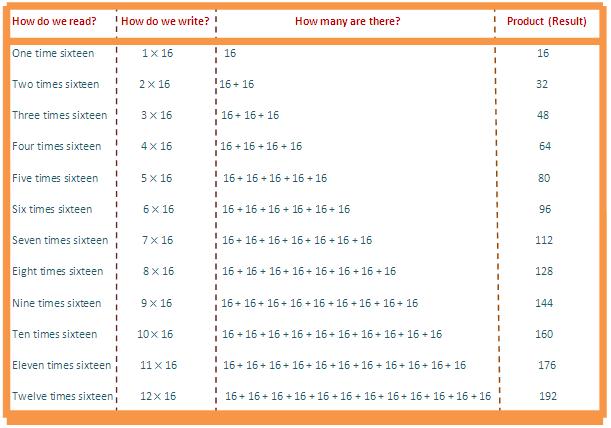Subscribe to our ▶️ YouTube channel 🔴 for the latest videos, updates, and tips.
16 Times Table
In 16 times table we will learn how to read and write multiplication table of 16.
We read sixteen times table as:
One time sixteen is 16
Two times sixteen are 32
Three times sixteen are 48
Four times sixteen are 64
Five times sixteen are 80
Six times sixteen are 96
Seven times sixteen are 112
Eight times sixteen are 128
Nine times sixteen are 144
Ten times sixteen are 160
Eleven times sixteen are 176
Twelve times sixteen are 192
We write 16 times table as:
1 × 16 = 16
2 × 16 = 32
3 × 16 = 48
4 × 16 = 64
5 × 16 = 80
6 × 16 = 96
7 × 16 = 112
8 × 16 = 128
9 × 16 = 144
10 × 16 = 160
11 × 16 = 176
12 × 16 = 192
Let us follow the how to read and write multiplication of 16 times table chart:
16 Times Table
Click Here to download the chart of 16 times table and then print it out.
This is the easiest way to learn 16 times table in the chart.
1. What is 16 × 16 × 16 × 16 × 16 × 16?
Answer: 16 × 6 [using 16 times table] = 96
2. Fill in the blanks:
(i) 10 more than 22 = 16 × ___
(ii) 5 times ___ = 80
(iii) 16 times ___ = 144
(iv) 1 less than 65 = 16 × ___
(v) 16 times 3 = ___
(vi) 3 more than 109 = ___ × ___
Answer:
2. (i) 10 more than 22 = 16 × 2
(ii) 5 times 16 = 80
(iii) 16 times 9 = 144
(iv) 1 less than 65 = 16 × 4
(v) 16 times 3 = 48
(vi) 3 more than 109 = 16 × 7
3. Using the multiplication time’s table of 16, calculate 16 times 12.
Solution:
According to the 16 times tables, 16 times 12 = 16 × 12 = 192
Therefore, 16 times 12 = 192
There are 16 packets of socks. Each packet has 2 pairs of socks. How many pairs of socks are there in 16 packets?
No of pairs of socks in 1 packet = 2
No of packets = 16
Therefore, total no. of pairs of socks in 16 packets = 2 × 16 = 32
Answer: There are 32 pairs of socks in 16 packets.
4. One bucket of water can fill 18 glasses. How many glasses can be filled from 16 such buckets?
Solution:
No of glasses can be filled from 1 bucket = 18
No of buckets = 16
Therefore, total no. of glasses can be filled from 16 buckets = 16 × 18 = 288
Answer: There will be 288 glasses filled from 16 buckets.
5. Ron drinks 10 glasses of water in a day. How many glasses of water he drinks in 16 days?
Solution:
No. of glasses of water in 1 day = 10
No. of days = 16
Therefore, total no. of glasses of water he drinks in 16 days = 10 × 16
Answer: He drank 160 glasses of water in 16 days.
6. In a packet there are 300 candies. How many candies are there in 16 such packets?
Solution:
No. of candies in 1 packet = 300
No. of packets = 16
Therefore, total no. of candies in 16 packets = 300 × 16
Answer: There will be 4800 candies in 16 packets.
0 Times Table. T 1 Times Table.
2 Times Table. A 3 Times Table.
4 Times Table. B 5 Times Table.
6 Times Table. L 7 Times Table.
8 Times Table. E 9 Times Table.
10 Times Table. 11 Times Table.
12 Times Table. T A B L E S C H A R T 13 Times Table.
14 Times Table. 15 Times Table.
16 Times Table. C 17 Times Table.
18 Times Table. H 19 Times Table.
20 Times Table. A 21 Times Table.
22 Times Table. R 23 Times Table.
24 Times Table. T 25 Times Table.
Multiplication Table Chart
From 16 Times Table to HOME PAGE
Didn't find what you were looking for? Or want to know more information about Math Only Math. Use this Google Search to find what you need.



New! Comments
Have your say about what you just read! Leave me a comment in the box below. Ask a Question or Answer a Question.